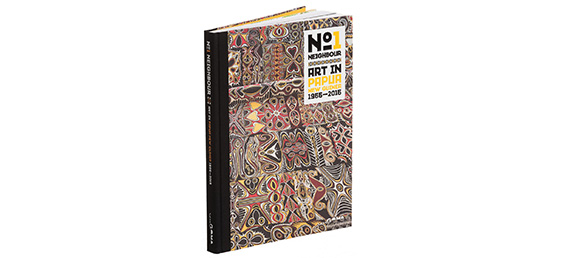Our major spring exhibition presents a snapshot of the contemporary art and culture to be found in this dynamic young nation. Here, we outline some of the highlights and their histories.

‘No.1 Neighbour: Art in Papua New Guinea 1966–2016’ is on view at the Queensland Art Gallery until 29 January 2017
Geographically, the mainland of Papua New Guinea lies just 3.7 kilometres from the island of Saibai in the Torres Strait, at the farnorthern tip of Queensland. Australia and Papua New Guinea share colonial and modern histories, yet PNG still holds a sense of mystery and mysticism in the Australian imagination: the drama and beauty of its landscapes and the rituals and customs of its people have inspired us for centuries. ‘No.1 Neighbour: Art in Papua New Guinea 1966-2016’ engages with what it means and has meant to live in this vibrant nation.
FOLLOW OUR INSTALLATION PROGRESS
As former PNG correspondent and ABC bureau chief Sean Dorney notes in his article (page 26) on the shared history of our countries, Australia governed Papua (1902–75) and the mandated territory of New Guinea (1921–75) until its independence in 1975. During this colonial period, many Australians worked in the ‘territories’ as kiaps (patrol officers), nurses, teachers, agriculturalists, anthropologists, policemen, architects and administrators. European systems of governance and law, education, health and administration flowed through the Australian administration to Papua New Guinea. Today, PNG is Australia’s biggest aid recipient, and many Australians continue to work there, maintaining close relationships with the country and its people.
‘No.1 Neighbour’ presents Australian audiences with a snapshot of the contemporary art and culture of Papua New Guinea. The exhibition highlights the diversity of the different cultures found in this dynamic young nation and brings together works from 9 of its 22 provinces. The breadth of creative expression is evident, ranging from bilas (ornamentation) and the masking traditions involved in sing-sing (gatherings of the tribes to share cultural traditions) through to bold explorations in printmaking and painting technologies, as well as the dynamism of music and dance.
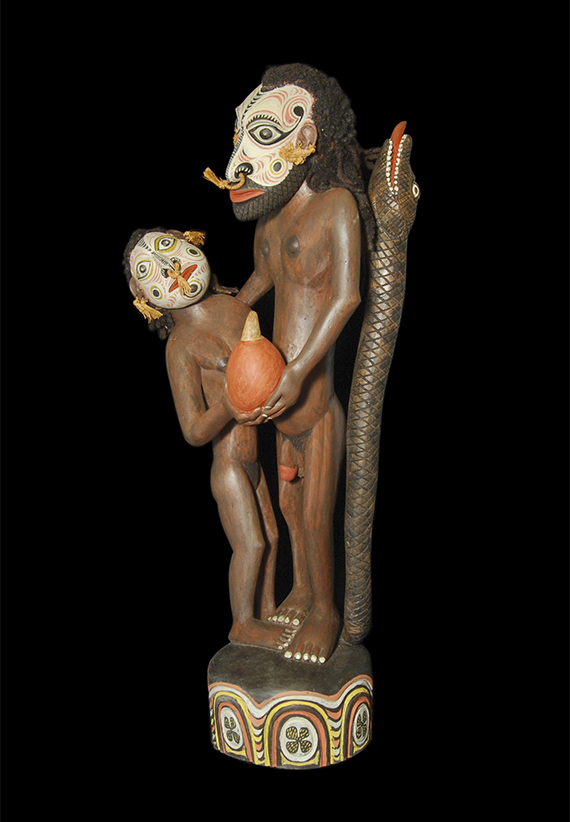
The first work visitors encounter in the exhibition — the spectacular Koromb (spirit house) 2012 ceiling by Kwoma artists from the East Sepik region — was commissioned by the Gallery for APT7 in 2012–13. It highlights the importance of such buildings as places of local decisionmaking. The work also references the Kwoma-inspired ceiling in Parliament House in Port Moresby and the more formal shared history between our countries. Another key work is painter Simon Gende’s No.1 Kiap long Australia Jim Taylor / Brukim Bush Gone Long Highlands Papua Nuigini 1991 — known for his playful exploration of key events and histories, Gende tells the story of Jim Taylor, a major figure in the colonial history of Papua New Guinea. As a kiap (patrol officer), Taylor led a series of expeditions into the Highlands during the 1930s, which saw this previously unexplored area opened up for pacification and change. Gende is part of a group of artists whose works can be described as history paintings — telling the modern and contemporary stories of PNG. Also included is a group of Tolai Tokatokoi (headdresses) 2011 with the traditional ancestor figure replaced with images of the Virgin Mary and a Sepik sculpture titled Adam and Eve 2011. These works illustrate the enduring influence of the church and the cultural impact of Christianity. In some cases, we can see the inventive ways in which artists and communities have responded to and integrated this new faith into their lives and culture; in others, a sense of enormous cultural loss.
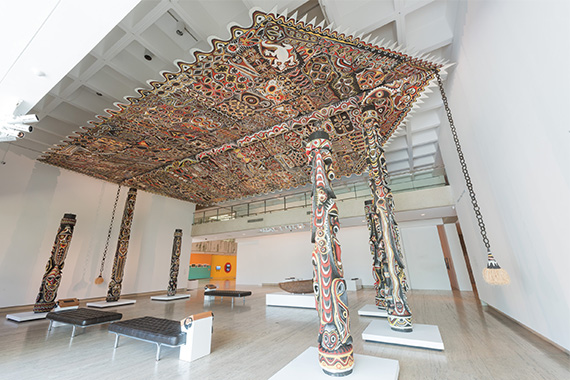
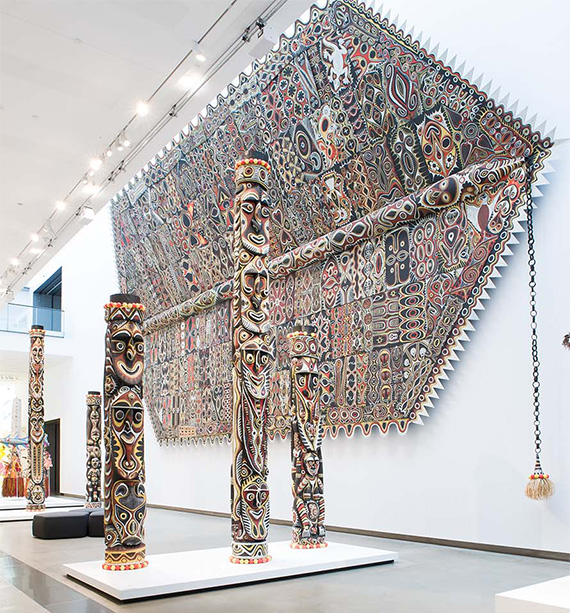
Commissioned especially for ‘No.1 Neighbour’ and led by Australian David Bridie of Wantok Musik Foundations, is the immersive installation a Bit na Ta (The source of the sea). This work, developed through historical analysis of the period between 1875 and 1975 by Tolai historian Gideon Kakabin, presents the history of the politically active Tolai people of East New Britain from their own perspective. Delivered through songs written collaboratively by celebrated Tolai musician George Telek and David Bridie, with input from Anslom Nakikus, the Matupit choir, elders Bung Marum and Revie Kinkin and the Gilnata, Moab and Amidel tribe string bands, among others, the installation exposes audiences to the events that shaped this century for the Tolai, including occupation by three colonial powers (including Australia), two World Wars and three volcanic eruptions. Music threads through all facets of Tolai life so it was important that this be the primary medium for the installation, which evokes a Tolai cultural space and history.
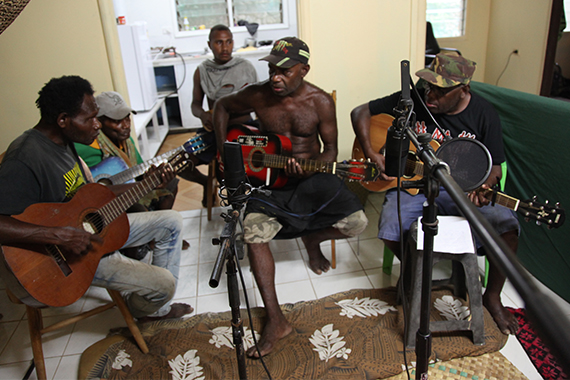
A major component of the exhibition examines the period immediately leading up to and after Independence in 1975, characterised by its creative experimentation and vibrancy. Artists such as Akis, Mathias Kauage, Jakupa Ako, David Lasisi and Simon Nowep are often heralded as initiating new more ‘modern’ forms of expression, transferring traditional body painting, architectural and mark making traditions to canvas and paper. These were men whose fathers could remember the arrival of white men in their lands and were some of the first to become Christians: these works record the meeting of the two worlds, drawing on customary forms of expression to record and make sense of the demands, temptations and experiences of alienation within the processes of national modernisation.
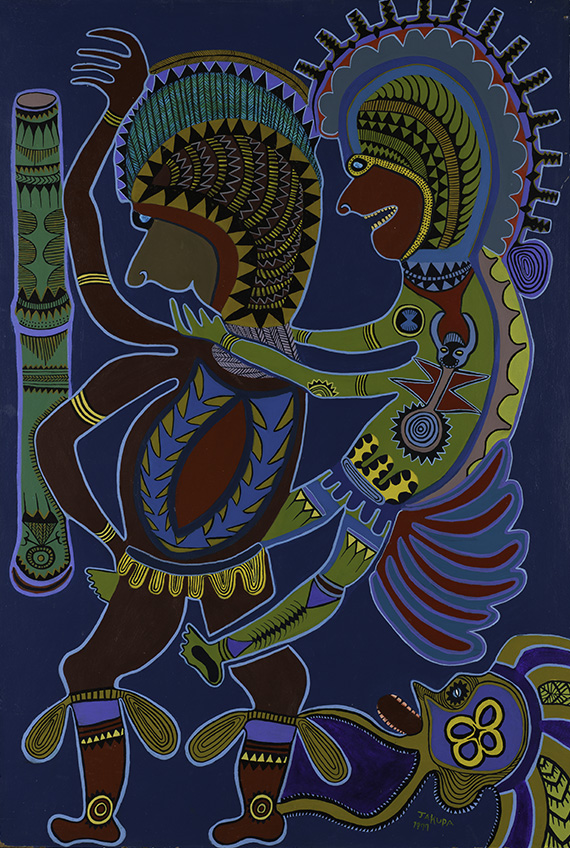
Artists also address the effect of these processes on the women of PNG within the exhibition. Modernisation changed traditional gender roles: women, who were relied on for their strong work ethic and maintenance of everyday life, have often stepped more easily into cash economies. The status accompanying this access to money has contributed to tension in existing hierarchies and gender balances — at times with violent ramifications. John Siune’s painting of a young couple split in two, with half of each partner dressed in traditional bilas and the other half in the urban attire associated with the world of ‘immoral’ white men, articulates these tensions and how they are often played out on women’s bodies.
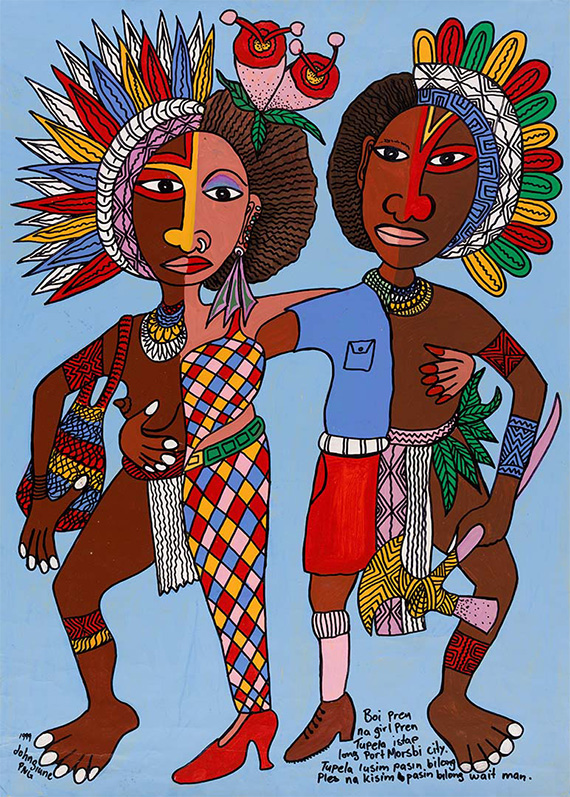
‘No.1 Neighbour’ also seeks to highlight the creativity of key Papua New Guinean women artists with the inclusion of works by Wendi Choulai, Mary Gole, the Ömie people, Florence Jaukae-Kamel, Lisa Hilli, and Julia Mage’au Gray and Taloi Havini (who were recently part of APT8). The assertion of gender parity and the acknowledgment of women’s importance in promoting a healthy and creative society is one of the strong threads that unite the artists’ practices.

A group of shields from the Waghi valley, a pair of woven pukpuk crocodiles by Iatmul artists (recognised for their initiatory skin-cutting practices), and the work of Australian-born Chimbu artist Eric Bridgeman, explore the contemporary expression of masculinity. Central to all is the maintenance of customary processes of collaboration that enable young men to interact with their peers, establishing important relationships and alliances.
The exhibition is accompanied by a range of public programs, extending our exploration and acknowledgment of the art of Papua New Guinea with a choreographed bilum event, an a Bit na Ta performance, storytelling, and a pottery and cooking demonstration. Expect bold colour, hauntingly beautiful singing, towering spectacular sculptural forms, lyrical lines, sensual textures, humour, and sparklingly sophisticated expressions of our shared history and responsibility for the future.
Philanthropist and inaugural chair of the National Portrait Gallery, Gordon Darling, AC, CMG (1921–2015), had great affection for Papua New Guinea. This exhibition project was generously supported by the Gordon Darling Foundation.
A substantial 144 page highly illustrated volume, No.1 Neighbour: Art in Papua New Guinea 1966–2016 celebrates the strength and diversity of contemporary art from Papua New Guinea, exploring works created from the mid 1960s, through Independence in 1975, to the present day. Available in-store and online
